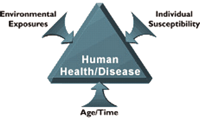Sites of interest on the World Wide Web—compiled by John W. Nelson
The Lowdown on CYPs
 Want to learn more than you thought possible about cytochrome P450–dependent metabolism and individual phenotypic variances?
Look no further than the home page of the Human Cytochrome P450 (CYP) Allele Nomenclature Committee , hosted by the Karolinska Institute (http://www.imm.ki.se/CypAlleles/). Not only will you find lists of allelic differences and single polymorphic nucleotides (SNPs) within the CYP genes, but more importantly, the effects of those nucleotide changes are documented as well. If that Web site has piqued
your interest, then you might turn to DNA & Drugs , a report on how genetic polymorphisms in CYP genes (and specifically CYP2D6 ) can affect drug metabolism in patients, as reported on National Public Radio (http:// discover.npr.org/features/feature.jhtml?wfId=1240979). An extensive primer as to which CYPs are responsible for the metabolism of specific drugs, and which drugs inhibit or enhance
the expression or activity of CYPs, can be found at The Cytochrome P-450 Enzyme System Web site managed by Edmund Hayes (Departments of Pharmacy and Medicine, University Medical Center, State University of New
York at Stony Brook) (http://www.edhayes.com/startp450.html). A press release located at the Astex Technology Web site cites their success in solving the first crystal structure of a human P450 molecule, 2C9, with a molecule of the
anticoagulant warfarin bound to it (http://www.astex-technology.co.uk/press_release.jsp?press_release_id=70). The structural data include an unusual binding pocket for warfarin. This knowledge might eventually lead to the development
of drugs to regulate CYP2C9 enzyme activity.
Want to learn more than you thought possible about cytochrome P450–dependent metabolism and individual phenotypic variances?
Look no further than the home page of the Human Cytochrome P450 (CYP) Allele Nomenclature Committee , hosted by the Karolinska Institute (http://www.imm.ki.se/CypAlleles/). Not only will you find lists of allelic differences and single polymorphic nucleotides (SNPs) within the CYP genes, but more importantly, the effects of those nucleotide changes are documented as well. If that Web site has piqued
your interest, then you might turn to DNA & Drugs , a report on how genetic polymorphisms in CYP genes (and specifically CYP2D6 ) can affect drug metabolism in patients, as reported on National Public Radio (http:// discover.npr.org/features/feature.jhtml?wfId=1240979). An extensive primer as to which CYPs are responsible for the metabolism of specific drugs, and which drugs inhibit or enhance
the expression or activity of CYPs, can be found at The Cytochrome P-450 Enzyme System Web site managed by Edmund Hayes (Departments of Pharmacy and Medicine, University Medical Center, State University of New
York at Stony Brook) (http://www.edhayes.com/startp450.html). A press release located at the Astex Technology Web site cites their success in solving the first crystal structure of a human P450 molecule, 2C9, with a molecule of the
anticoagulant warfarin bound to it (http://www.astex-technology.co.uk/press_release.jsp?press_release_id=70). The structural data include an unusual binding pocket for warfarin. This knowledge might eventually lead to the development
of drugs to regulate CYP2C9 enzyme activity.
Monoclonal Antibody–Based Treatments
 If information on monoclonal antibody (MAb) therapy (passive immunotherapy) is more to your liking, then visit the American
Cancer Society’s Monoclonal Antibody Therapy (Passive Immunotherapy) Web site (http://www.cancer.org/docroot/ETO/content/ETO_1_4X_Monoclonal_Antibody_Therapy_Passive_Immunotherapy.asp?sitearea=ETO). This site covers, not surprisingly, specific MAb-related treatments and discusses, at great length, the differences between
naked and conjugated MAbs, and which MAbs are FDA-approved for use. In addition to the review in this issue of MI by Fleischmann and Shealy on MAb-based therapies, read About Crohn’s Disease Drug Therapy (http://www.crohnsresource.com/about/drug.html) to learn more about the debilitating inflammatory disease of the bowel and its treatment. Monoclonal Antibody Therapy in lymphoma is described by the Lymphoma Information Network (http://www.lymphomainfo.net/therapy/immunotherapy/mab.html). A Web site created by Genentech also provides a convenient FAQ with much useful information on Therapeutic Antibodies in the Treatment of Non-Hodgkin’s Lymphoma (http://www.gene.com/gene/products/education/oncology/faq-treatment-lymphoma.jsp). Information that specifically relates to MAb treatments for psoriasis (i.e., Amevive®), as well as other therapies in the pipeline, can also be found at the same Genentech URL.
If information on monoclonal antibody (MAb) therapy (passive immunotherapy) is more to your liking, then visit the American
Cancer Society’s Monoclonal Antibody Therapy (Passive Immunotherapy) Web site (http://www.cancer.org/docroot/ETO/content/ETO_1_4X_Monoclonal_Antibody_Therapy_Passive_Immunotherapy.asp?sitearea=ETO). This site covers, not surprisingly, specific MAb-related treatments and discusses, at great length, the differences between
naked and conjugated MAbs, and which MAbs are FDA-approved for use. In addition to the review in this issue of MI by Fleischmann and Shealy on MAb-based therapies, read About Crohn’s Disease Drug Therapy (http://www.crohnsresource.com/about/drug.html) to learn more about the debilitating inflammatory disease of the bowel and its treatment. Monoclonal Antibody Therapy in lymphoma is described by the Lymphoma Information Network (http://www.lymphomainfo.net/therapy/immunotherapy/mab.html). A Web site created by Genentech also provides a convenient FAQ with much useful information on Therapeutic Antibodies in the Treatment of Non-Hodgkin’s Lymphoma (http://www.gene.com/gene/products/education/oncology/faq-treatment-lymphoma.jsp). Information that specifically relates to MAb treatments for psoriasis (i.e., Amevive®), as well as other therapies in the pipeline, can also be found at the same Genentech URL.
Genomics and the Big Picture
Some people are genetically predisposed to certain cancers, whereas exposure to some toxic chemicals seems to invariably result in cancer no matter what genetic alleles a person may have. The Environmental Genome Project (EGP) (http://www.niehs.nih.gov/envgenom/home.htm), created in 1998 by the National Institute of Environmental Health Sciences (NIEHS), seeks to understand the nebulous interplay of susceptibility and exposure in disease. To date, of approximately 500 genes thought to influence susceptibility to disease, some 200 have been partially characterized. And increasing urgency is now being brought to the goal of understanding how individuals differ in their susceptibility to environmental agents and how these susceptibilities change over time. A section on the EGP Web site entitled “Ethical, Legal, and Social Implications” deals with the dilemmas that inevitably arise from obtaining genetic data of patients and volunteers. Similarly, The Cancer Genome Anatomy Project (CGAP) of the National Cancer Institute (http://www3.cancer.gov/initiatives/cgap.html), created in 1997, seeks to understand the molecular basis of cancer. One of five projects within the CGAP, the Human Tumor Gene Index (http://cgap.nci.nih.gov/Genes) seeks “to identify genes expressed during development of human tumors.” Other CGAP resources available at the CGAP Web site (http://cgap.nci.nih.gov/) cover expression patterns in tissues, protein complexes and signaling pathways, chromosomal gene maps, and data mining tools. See also the related link (http://www.ncbi.nlm.nih.gov/CGAP/).

- © American Society for Pharmacology and Experimental Theraputics 2003



